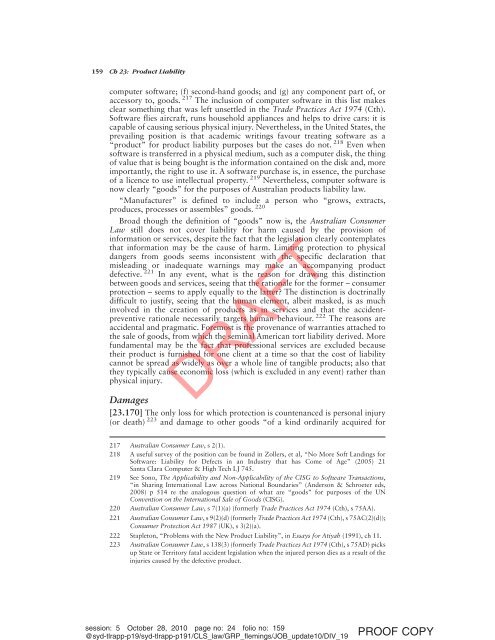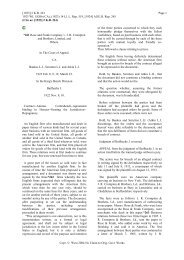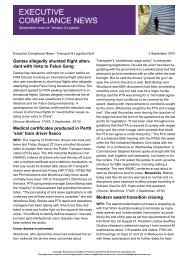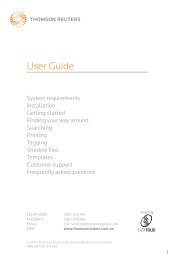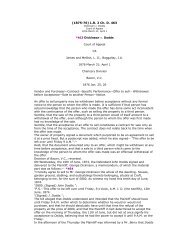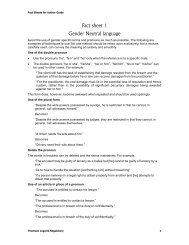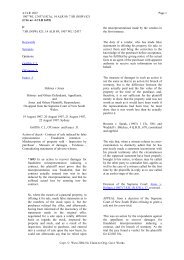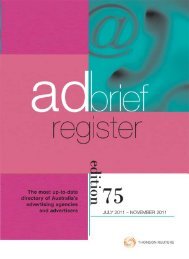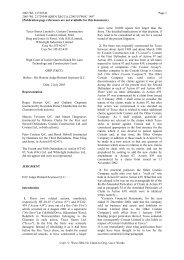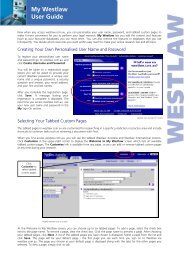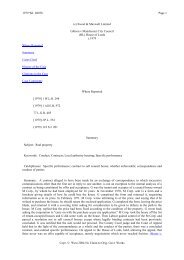Chapter 23: Product Liability - Thomson Reuters
Chapter 23: Product Liability - Thomson Reuters
Chapter 23: Product Liability - Thomson Reuters
You also want an ePaper? Increase the reach of your titles
YUMPU automatically turns print PDFs into web optimized ePapers that Google loves.
159Ch <strong>23</strong>: <strong>Product</strong> <strong>Liability</strong>computer software; (f) second-hand goods; and (g) any component part of, oraccessory to, goods. 217 The inclusion of computer software in this list makesclear something that was left unsettled in the Trade Practices Act 1974 (Cth).Software flies aircraft, runs household appliances and helps to drive cars: it iscapable of causing serious physical injury. Nevertheless, in the United States, theprevailing position is that academic writings favour treating software as a“product” for product liability purposes but the cases do not. 218 Even whensoftware is transferred in a physical medium, such as a computer disk, the thingof value that is being bought is the information contained on the disk and, moreimportantly, the right to use it. A software purchase is, in essence, the purchaseof a licence to use intellectual property. 219 Nevertheless, computer software isnow clearly “goods” for the purposes of Australian products liability law.“Manufacturer” is defined to include a person who “grows, extracts,produces, processes or assembles” goods. 220Broad though the definition of “goods” now is, the Australian ConsumerLaw still does not cover liability for harm caused by the provision ofinformation or services, despite the fact that the legislation clearly contemplatesthat information may be the cause of harm. Limiting protection to physicaldangers from goods seems inconsistent with the specific declaration thatmisleading or inadequate warnings may make an accompanying productdefective. 221 In any event, what is the reason for drawing this distinctionbetween goods and services, seeing that the rationale for the former – consumerprotection – seems to apply equally to the latter? The distinction is doctrinallydifficult to justify, seeing that the human element, albeit masked, is as muchinvolved in the creation of products as in services and that the accidentpreventiverationale necessarily targets human behaviour. 222 The reasons areaccidental and pragmatic. Foremost is the provenance of warranties attached tothe sale of goods, from which the seminal American tort liability derived. Morefundamental may be the fact that professional services are excluded becausetheir product is furnished for one client at a time so that the cost of liabilitycannot be spread as widely as over a whole line of tangible products; also thatthey typically cause economic loss (which is excluded in any event) rather thanphysical injury.DRAFTDamages[<strong>23</strong>.170] The only loss for which protection is countenanced is personal injury(or death) 2<strong>23</strong> and damage to other goods “of a kind ordinarily acquired for217 Australian Consumer Law, s 2(1).218 A useful survey of the position can be found in Zollers, et al, “No More Soft Landings forSoftware: <strong>Liability</strong> for Defects in an Industry that has Come of Age” (2005) 21Santa Clara Computer & High Tech LJ 745.219 See Sono, The Applicability and Non-Applicability of the CISG to Software Transactions,“in Sharing International Law across National Boundaries” (Anderson & Schroeter eds,2008) p 514 re the analogous question of what are “goods” for purposes of the UNConvention on the International Sale of Goods (CISG).220 Australian Consumer Law, s 7(1)(a) (formerly Trade PracticesAct 1974 (Cth), s 75AA).221 AustralianConsumerLaw, s 9(2)(d) (formerlyTradePracticesAct1974 (Cth), s 75AC(2)(d));Consumer ProtectionAct 1987 (UK), s 3(2)(a).222 Stapleton, “Problems with the New <strong>Product</strong> <strong>Liability</strong>”, in Essays forAtiyah (1991), ch 11.2<strong>23</strong> AustralianConsumerLaw, s 138(3) (formerlyTradePracticesAct1974 (Cth), s 75AD) picksup State or Territory fatal accident legislation when the injured person dies as a result of theinjuries caused by the defective product.session: 5 October 28, 2010 page no: 24 folio no: 159@syd-tlrapp-p19/syd-tlrapp-p191/CLS_law/GRP_flemings/JOB_update10/DIV_19PROOF COPY


